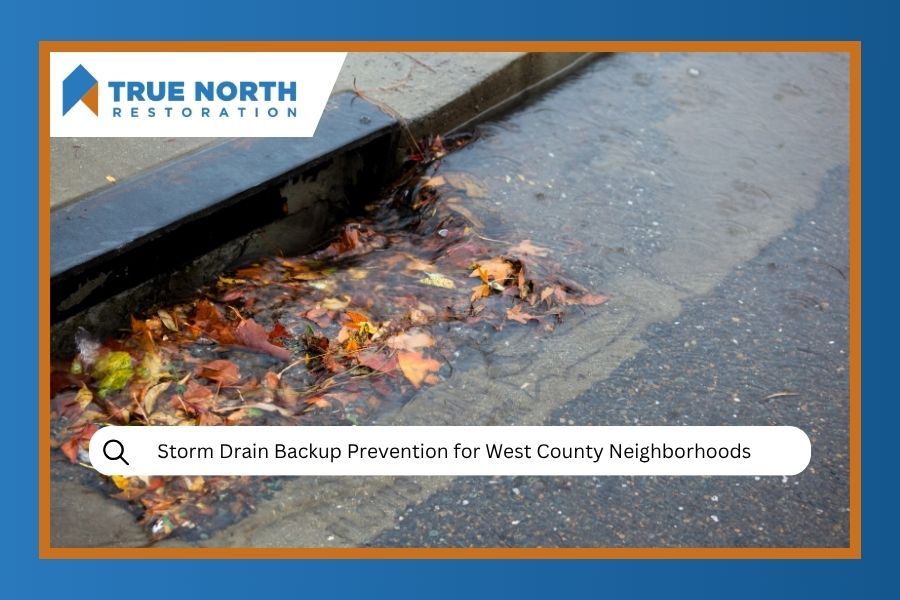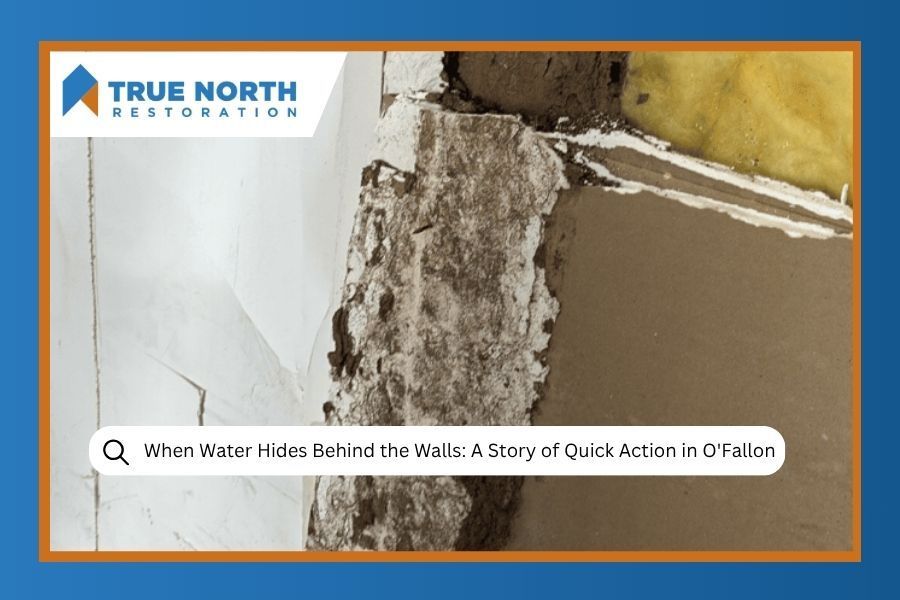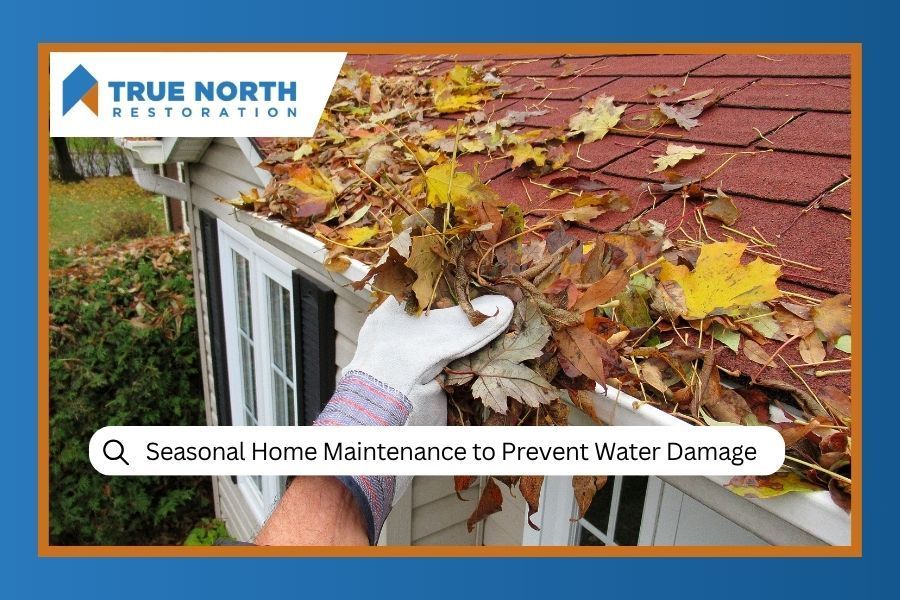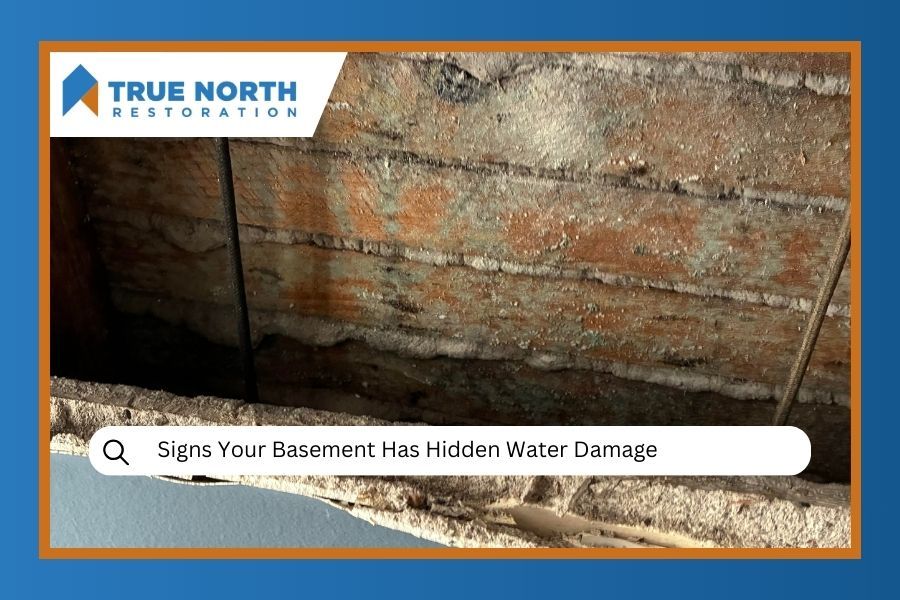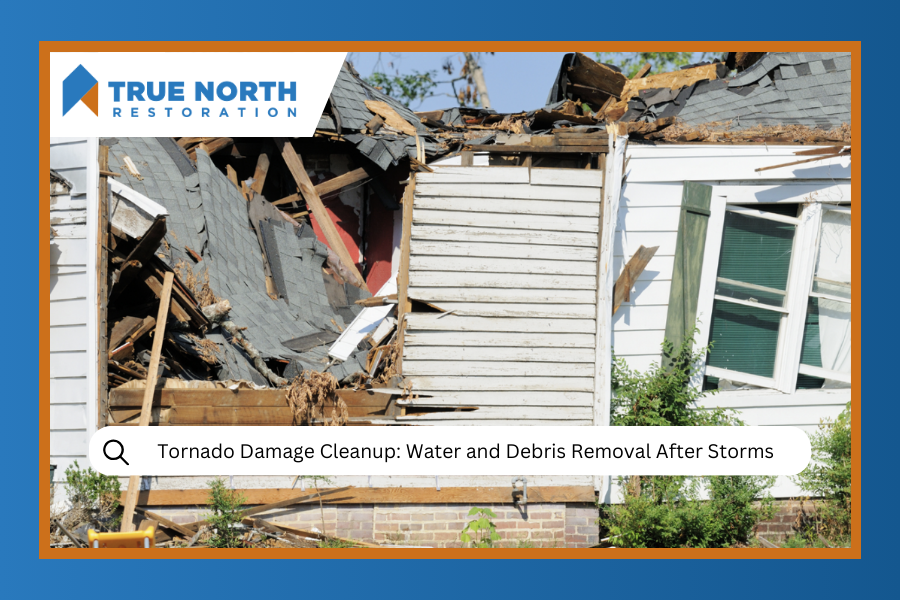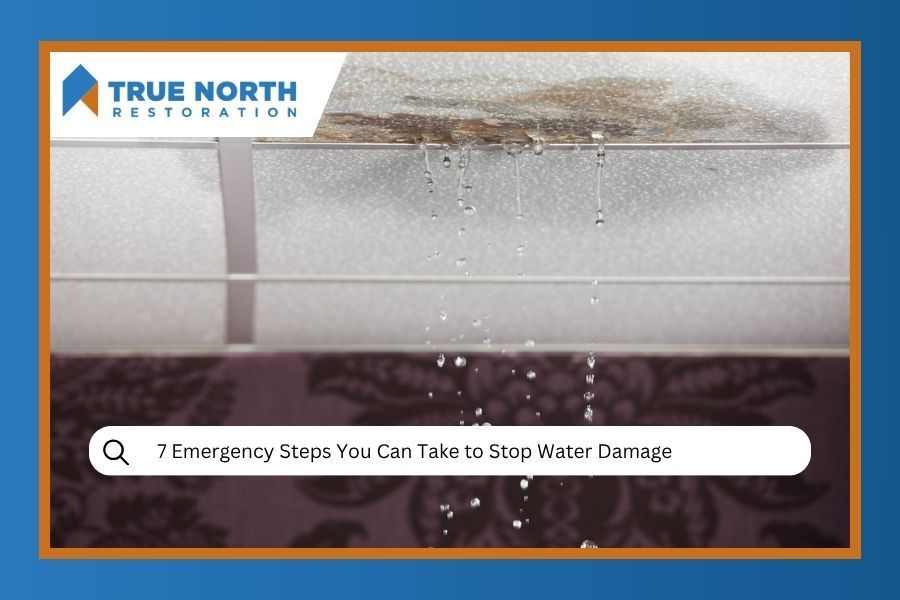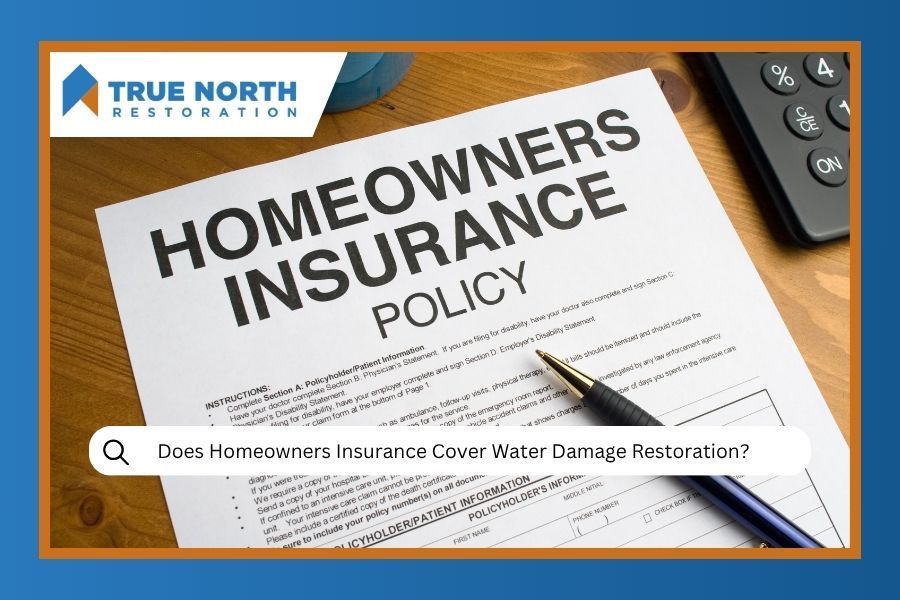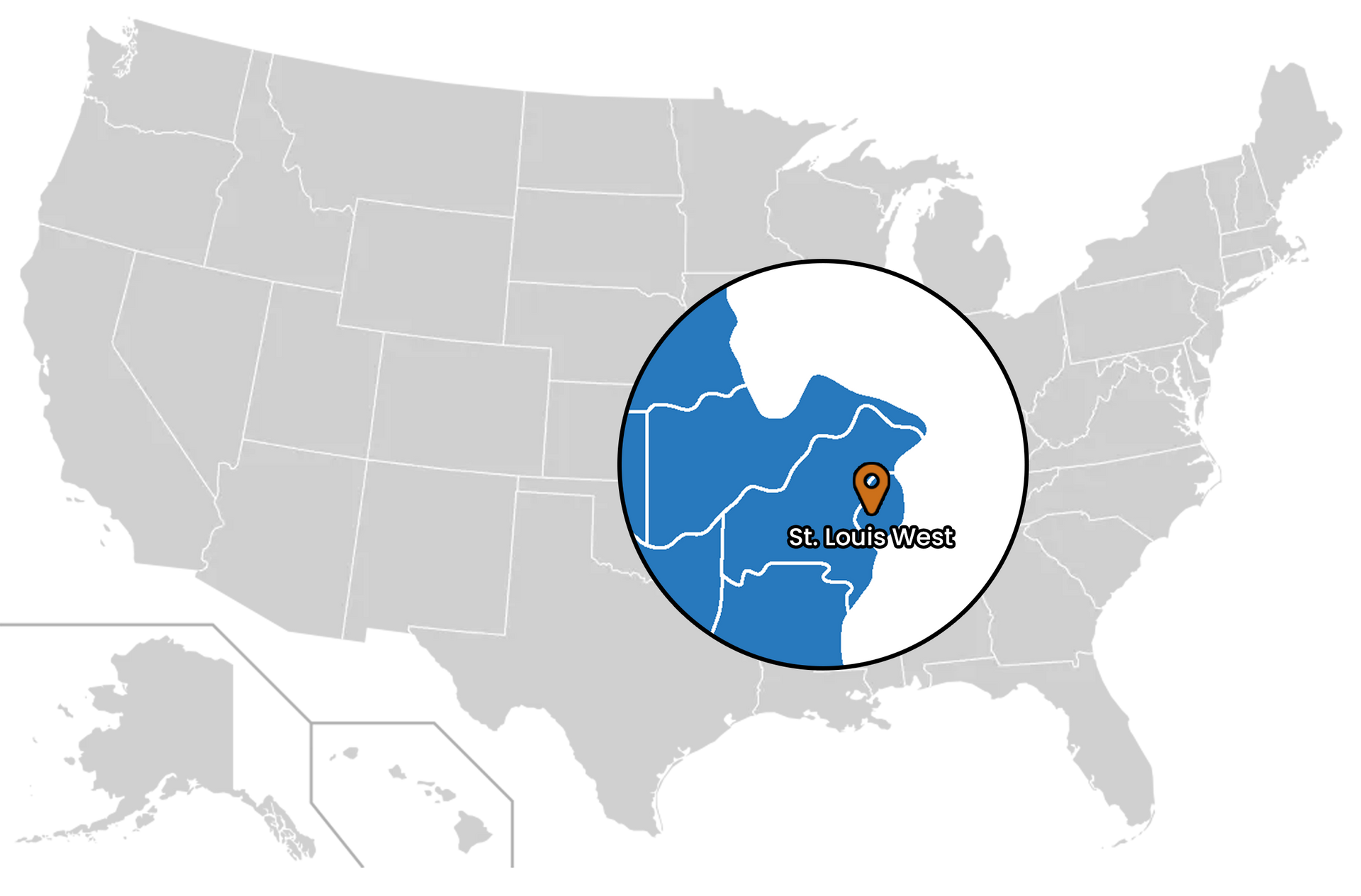Jump To:
We've all been there. You're watching the weather report, and they're calling for heavy rain across St. Charles County and West County. You might think, "Great, the lawn needs it." But then you remember that time your neighbor's basement turned into an indoor swimming pool because of a storm drain backup, and suddenly that forecast doesn't sound so refreshing.
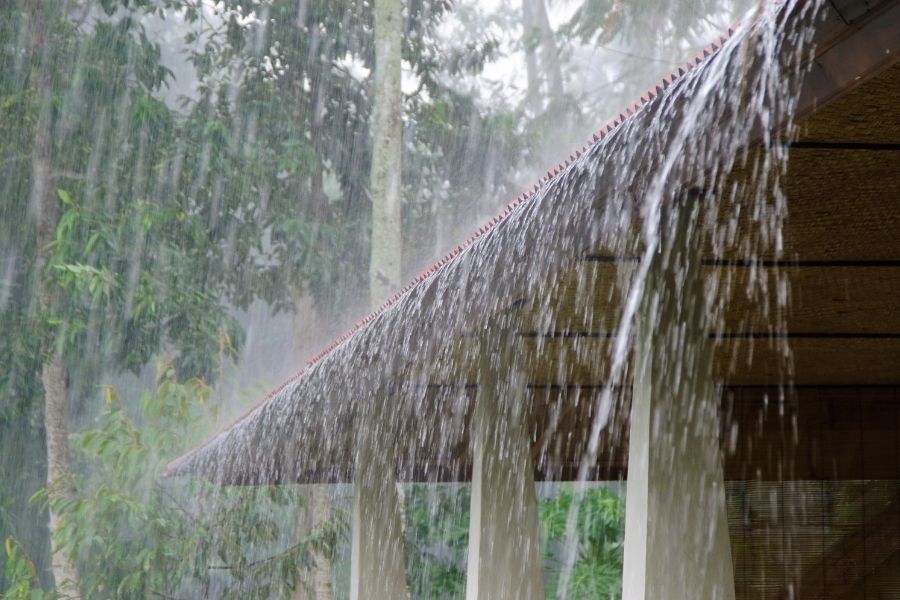
At True North Restoration of Greater St. Louis West, we've seen what happens when storm drains can't handle the water load during Missouri's unpredictable weather. From emergency water damage restoration to preventive guidance, we help West County homeowners stay ahead of flooding issues. The good news? Most storm drain backup disasters are totally preventable with some proactive steps and a little know-how.
Understanding Storm Drain Systems in West County
Let's start with the basics. Storm drains are designed to carry rainwater away from streets and neighborhoods, directing it to local waterways. Here in West County, our municipal drainage systems work pretty well most of the time, but they're not invincible.
During heavy downpours (which we get plenty of during spring and fall), these systems can get overwhelmed. When that happens, water has to go somewhere, and unfortunately, that somewhere might be your basement or crawl space. The worst part? Insurance companies often treat storm drain backups differently than other types of water damage, so prevention is your best bet.
Common Causes of Storm Drain Backups
Understanding why backups happen helps you prevent them:
- Debris blockages from leaves, trash, and sediment
- Overwhelmed capacity during heavy rainfall events
- Tree root infiltration into older drain systems
- Structural damage from ground settling or construction
- Ice blockages during freeze-thaw cycles (yes, this happens here in Missouri)
Fall Storm Season Preparation Checklist
Fall is actually the perfect time to prep for storm season. Here's your action plan:
Property-Level Prevention
Keep Your Gutters and Downspouts Clear
- Clean gutters twice per year (minimum)
- Install gutter guards if you have lots of trees
- Ensure downspouts direct water at least 6 feet from your foundation
- Check for loose or damaged gutter connections
Maintain Your Yard's Drainage
- Keep storm drains in your neighborhood clear of leaves and debris
- Grade your lawn so water flows away from your home
- Consider adding rain gardens or permeable surfaces
- Trim tree branches that hang over storm drains
Basement and Foundation Protection
- Test your sump pump before storm season (and get a backup if you don't have one)
- Seal any foundation cracks
- Install a backwater valve if your area is prone to sewer backups
- Keep valuable items elevated in basement storage
Create Emergency Water Barriers
- Sandbags aren't just for riverfront properties
- Consider permanent flood barriers for vulnerable entry points
- Know where your main water shut-off valve is located
- Keep a wet-dry vacuum accessible for minor flooding
Need Professional Help Protecting Your Home?
Our certified team at True North Restoration provides 24/7 emergency water damage restoration services throughout Chesterfield and West County. Don't wait until disaster strikes!
Contact Us TodayCall us at (314) 557-3990 for immediate assistance
How Municipal Systems Work (And When They Don't)
Your local municipality maintains the storm drain system, but that doesn't mean you're off the hook for protecting your property. Most West County communities have aging infrastructure that wasn't designed for today's development density or increasingly intense storm events.
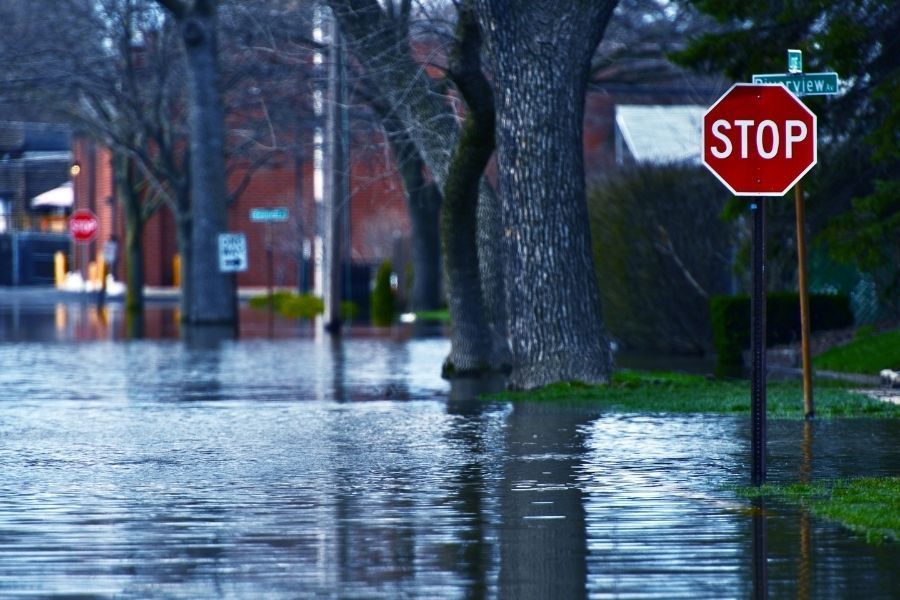
When to Contact Your Municipality
You should report these issues to your local public works department:
- Storm drains clogged with debris
- Visible damage to catch basins or drainage structures
- Standing water that persists 24+ hours after rain
- Strong sewage odors coming from storm drains
What You Can Do Yourself
While major infrastructure is the city's responsibility, homeowners can help by:
- Keeping the storm drain nearest your home clear of leaves and trash
- Never dumping anything down storm drains (they flow directly to local waterways)
- Reporting problems promptly
- Understanding your neighborhood's drainage patterns
Signs Your Area May Be at Risk
Not all neighborhoods are created equal when it comes to storm drain backup risk. Watch for these warning signs in your area:
Topography Red Flags
- Homes at the bottom of hills or slopes
- Properties near natural low points or former creek beds
- Areas with poor soil drainage
Infrastructure Warning Signs
- Frequent street flooding during moderate rain
- Multiple homes in the neighborhood with sump pumps
- Storm drains that seem undersized for the area
- Neighborhoods built before modern drainage standards
Historical Indicators
- Previous flooding events in your area
- Multiple water damage insurance claims in your neighborhood
- Local flood zone designations
Emergency Response: When Prevention Isn't Enough
Sometimes Mother Nature wins, no matter how well you've prepared. When that happens, knowing what to do in the first few hours can save you thousands in damage.
Immediate Actions During Flooding
- Safety first- Never enter standing water if there's any chance of electrical hazards
- Stop the source if possible (sometimes it's a simple clogged drain you can clear)
- Document everything with photos for insurance purposes
- Call for help- Don't try to handle major flooding alone
When to Call the Professionals
Time is critical with water damage. You should call restoration experts immediately if you have:
- More than 2 inches of standing water
- Water that's been sitting for more than 24 hours
- Any signs of contamination (sewage backup)
- Electrical systems that may have been compromised
Our team at True North Restoration responds to emergencies 24/7 with our 45-minute response time guarantee. We've helped countless West County families recover from storm damage, and we know how to work with insurance companies to make the process as smooth as possible.
If you're dealing with water damage right now, we also provide mold remediation services since standing water can quickly lead to mold growth in as little as 24-48 hours.
Get Emergency Help NowSeasonal Maintenance Calendar
| Season | Key Tasks | Priority Level |
|---|---|---|
| Spring (March-May) | Clean gutters after winter, test sump pump systems, check foundation for winter damage, clear storm drains of winter debris | High |
| Summer (June-August) | Monitor drainage during summer storms, keep gutters clear of growing vegetation, maintain yard grading and drainage | Medium |
| Fall (September-November) | Major gutter cleaning (most important time), prepare emergency supplies, check basement waterproofing, clear leaves from storm drains weekly | Critical |
| Winter (December-February) | Prevent ice dams on gutters, monitor for freeze-thaw foundation issues, keep storm drains clear of snow and ice, test emergency equipment | Medium |
Working with Insurance and Contractors
Here's something most homeowners don't know: storm drain backups and sewer backups are often treated differently by insurance companies than other types of water damage. Some policies exclude them entirely unless you have specific riders.
Before Damage Occurs
- Review your insurance policy with your agent
- Consider adding sewer backup coverage if you don't have it
- Document your home's drainage systems with photos
- Keep receipts for any preventive measures you install
After Damage Occurs
- Call your insurance company immediately
- Work with certified restoration professionals who understand insurance procedures
- Keep detailed records of all communication and expenses
At True North Restoration, we handle insurance claims coordination as part of our service, taking that stress off your shoulders during an already difficult time. We also offer free inspections to help identify potential water damage issues before they become major problems.
Frequently Asked Questions
Q: What's the main difference between municipal storm drains and my home's drainage system when it comes to backup prevention?
A: Municipal storm drains handle street runoff and are maintained by your city, while your home's drainage (gutters, downspouts, foundation drains) is your responsibility. Storm drain backups typically happen when the municipal system gets overwhelmed, but you can protect your property by ensuring your home's water flows properly to those municipal drains and doesn't pool around your foundation where it can seep into basements.
Q: During West County's heavy spring rains, what are the warning signs that a storm drain backup might be imminent in my neighborhood?
A: Watch for standing water in streets that doesn't drain within 2-3 hours after rain stops, gurgling sounds from floor drains in your basement, water pooling consistently in the same spots near storm drains, and neighbors reporting minor basement seepage. If you see multiple homes in your area using sump pumps frequently, that's also a sign your neighborhood's drainage system is under stress.
Q: If I install preventive measures like backwater valves or upgrade my sump pump, will that help specifically with storm drain backups?
A: Backwater valves help prevent sewer backups but won't stop storm drain overflow from entering through foundation cracks or overwhelming your drainage system from above ground. For storm drain backup prevention, focus on proper grading, gutter maintenance, and ensuring water flows away from your foundation. Sump pump upgrades help manage groundwater but won't stop surface flooding from overwhelmed street drains.
Q: What should I do immediately if storm water starts backing up into my basement during a heavy downpour?
A: First, ensure electrical safety, turn off power to the affected area if possible. Don't try to pump water out while it's still actively flooding, as this can cause structural damage. Focus on moving valuables to higher ground and documenting damage with photos. Once the rain stops and water levels stabilize, that's when you call us at (314) 557-3990. Storm drain backup water is generally cleaner than sewage, but it still requires proper drying and sanitization to prevent mold growth.
When Your World Heads South, Go True North
Storm drain backups don't have to turn your home upside down. With proper preparation and the right response when problems occur, you can protect your West County property from costly water damage.
Remember, prevention is always cheaper than restoration, but when prevention isn't enough, having a reliable restoration partner makes all the difference. Our certified team at True North Restoration of Greater St. Louis West has helped families throughout Chesterfield, St. Charles County, and West County recover from water damage quickly and completely.
If you're dealing with water damage from storm drain backups, flooding, or any other water emergency, don't wait. Call us at (314) 557-3990 for immediate assistance, or contact us online to schedule an inspection.
For more helpful information about protecting your home from water damage, check out our guides on water damage prevention and learn about what water damage looks like so you can catch problems early. You can also read about how we helped other homeowners with emergency moisture cleanup when prevention wasn't enough.
True North Restoration of Greater St. Louis West provides 24/7 emergency water damage restoration, mold remediation, and storm damage cleanup services throughout Chesterfield, St. Charles County, and West County communities. Our IICRC-certified professionals are ready to help restore your home and your peace of mind.



